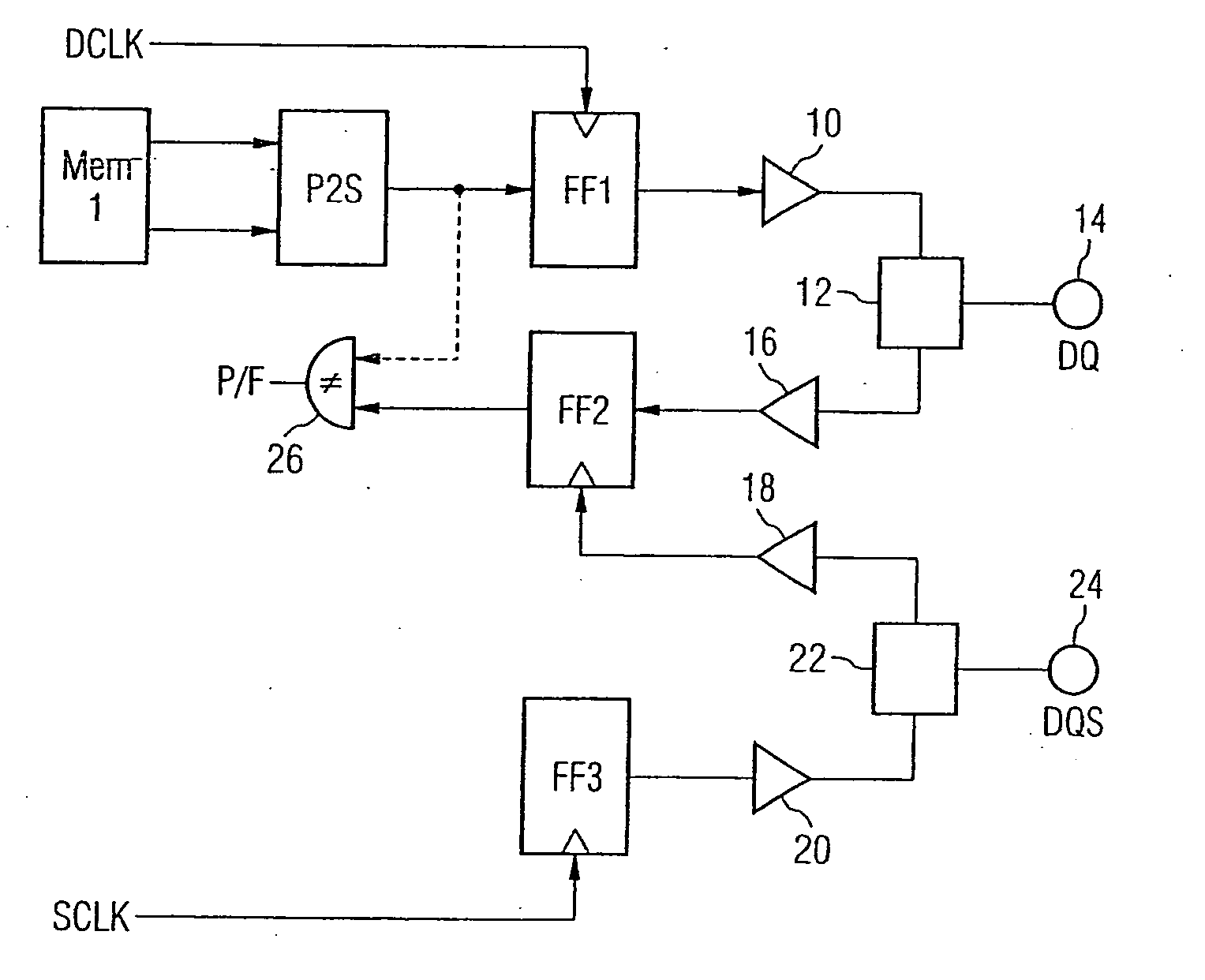Loop-back method for measuring the interface timing of semiconductor memory devices using the normal mode memory
- Summary
- Abstract
- Description
- Claims
- Application Information
AI Technical Summary
Benefits of technology
Problems solved by technology
Method used
Image
Examples
first embodiment
[0091]FIG. 2 shows a similar view to FIG. 1. Elements of the semiconductor memory device which are the same as in the first embodiment are designated by the same reference symbols, and a detailed description thereof is dispensed with.
[0092] The semiconductor memory device in accordance with the second embodiment generally has the same structure as the semiconductor memory device in accordance with the first embodiment, the difference being that the comparison device 26 is not provided. In the semiconductor memory device shown, the output of the second flip-flop FF2 is signal-connected to a second memory area Mem 2 via a serial-to-parallel conversion device S2P.
[0093] The functioning of the semiconductor memory device during normal operation is the same as that of the semiconductor memory device in accordance with the first embodiment.
[0094] In test operation, the output signal of the second flip-flop FF2 is not compared with the test input data, as in the first embodiment. Rather,...
third embodiment
[0096] A third preferred embodiment of the present invention will now be described with reference to FIG. 3. FIG. 3 is a schematic view of a semiconductor memory device in accordance with a
[0097] The embodiment shown in FIG. 3 corresponds to that embodiment shown in FIG. 2 with the difference that an external loop is formed in the test mode. In this case, a first data contact 30 is signal-connected to a second data contact 32 via an external load resistor RL. The first data contact 30 is signal-connected to a first data pad 34, and the second data contact 32 is signal-connected to a second data pad 36. In a similar manner, two data clock contacts 38 and 40 are signal-connected to one another via an external load resistor RL during the test mode.
second embodiment
[0098] In the test mode, an external loop is formed by the output driver 10, which is signal-connected to the first data pad 34, the first data contact 30, the second data contact 32, the second data pad 36 and the input driver 16, which is signal-connected to the second data pad 36. In this case, the output drivers 10 and input drivers 16 are in each case switched such that the output driver 10 associated with a first data contact enables a signal transmission, and the input driver 16 of the associated data contact 32 in the pair-wise arrangement of two data contacts enables a signal transmission. The respective other output drivers 10 and input drivers 16 are switched such that signal transmission is not made possible. A similar arrangement is produced for the data clock signals DQS. The operation of the semiconductor memory device in the test mode is the same as that in accordance with the second embodiment, and a detailed description thereof is dispensed with.
[0099] Further embo...
PUM
 Login to View More
Login to View More Abstract
Description
Claims
Application Information
 Login to View More
Login to View More - R&D
- Intellectual Property
- Life Sciences
- Materials
- Tech Scout
- Unparalleled Data Quality
- Higher Quality Content
- 60% Fewer Hallucinations
Browse by: Latest US Patents, China's latest patents, Technical Efficacy Thesaurus, Application Domain, Technology Topic, Popular Technical Reports.
© 2025 PatSnap. All rights reserved.Legal|Privacy policy|Modern Slavery Act Transparency Statement|Sitemap|About US| Contact US: help@patsnap.com



